Fenobest
"Discount fenobest on line, menstrual bleeding for 2 weeks".
By: H. Tizgar, MD
Clinical Director, Des Moines University College of Osteopathic Medicine
The problem begins in childhood pregnancy emotions order fenobest canada, in boys three times more usually than ladies menses generic 20mg fenobest fast delivery, often as a simple tic; as the situation progresses pregnancy 23 weeks 10mg fenobest with visa, new tics are added to the repertoire. It is the multiplicity of tics and the mix of motor and vocal tics that distinguish the Tourette syndrome from the more benign, restricted tic problems. Some sufferers show repetitive and annoying motor conduct, such as jumping, squatting, or turning in a circle. Interestingly, the latter phenomena are unusual in Japanese sufferers, whose decorous culture and language comprise few obscenities. The full repertoire of tics and compulsions comprised by the Tourette syndrome has been described by Tolosa and Bayes and in the evaluations by Jankovic and by Leckman, that are really helpful. Stone and Jankovic have famous the occurrence of persistent blepharospasm, torticollis, and other dystonic fragments in a small number of sufferers with Tourette syndrome. Isometric contractions of isolated muscle groups (tonic tics) also happen in some sufferers. In half of adolescents the tics subside spontaneously by early maturity and those who persist turn out to be milder with time. Others endure long remissions only to have tics recur, but in other sufferers the motor dysfunction persists all through life. This variability emphasizes the issue in separating transient behavior spasms from the Tourette continual multiple tic syndrome. Isolated and gentle but lifelong motor tics probably represent a variant of Tourette syndrome insofar as they show the identical predominantly male heredofamilial sample and similar responses to medication. As to behavioral disturbances, an attention-deficit hyperactivity dysfunction (see page 511), obsessive-compulsive traits, or each are said to be evident at a while in the middle of the illness, and these intervene to a higher diploma than do the tics with progress in class. Poor management of temper, impulsiveness, self-injurious conduct, and certain sociopathic traits are seen in some but certainly not all affected youngsters. In one-third of the cases reported by Shapiro and colleagues, tics were observed in other family members. Several other research have reported a familial clustering of cases by which the sample of transmission seems to be autosomal dominant with incomplete penetrance (Pauls and Leckman) but this has been disputed and several other potential patterns of transmission that comprise predisposing genes have been discovered by linkage analysis. In any genetic explanation, the marked predominance of males should be accounted for. Nonetheless, help for the primary genetic nature of Tourette syndrome derives from twin research, which have revealed higher concordance rates in monozygotic twin pairs than in dizygotic pairs. An ethnic bias (Ashkenazi Jews) has been reported, ranging from 19 to 62 % in several collection, but this has not been borne out in equally massive collection outside of New York (Lees et al). Reports of a relationship to obsessivecompulsive neurosis have also been inconsistent. Magnetic resonance imaging has proven no uniform abnormalities, and practical imaging has demonstrated numerous but inconsistent abnormalities. However, Singer and coworkers, who analyzed pre- and postsynaptic dopamine markers in postmortem striatal tissue, discovered a significant alteration of dopamine uptake mechanisms; more recently, Wolf and colleagues have discovered that variations in D2 dopamine receptor binding in the head of the caudate nucleus mirrored variations in the phenotypic severity of Tourette syndrome. These observations, coupled with the information that L-dopa exacerbates the signs of Tourette syndrome and that haloperidol, which blocks dopamine (particularly D2) receptors, is an effective treatment, help the notion of a dopaminergic abnormality in the basal ganglia, more particularly in the caudate nucleus. In this respect, reported cases of compulsive conduct in relation to lesions in the head of the caudate nucleus and its projections from orbitofrontal and cingulate cortices could also be pertinent. Using the model of Sydenham chorea, a recent line of investigation has implicated streptococcal an infection in the genesis of abruptly appearing Tourette syndrome and of much less generalized tics in youngsters. This affiliation has also been adopted by some authors to explain obsessive-compulsive conduct of sudden and unexplained onset. The alpha2-adrenergic agonists clonidine and guanfacine have been helpful in several research, but not in others. The newer drug, guanfacine has the benefit over clonidine of daily dosing and less sedating effect. The neuroleptics haloperidol, pimozide, sulpiride, and tiapride have proved to be efficient therapeutic agents but must be used only in severely affected sufferers and only after the adrenergic agents have been tried. Pimozide, which has a more specific antidopaminergic motion than haloperidol, could also be simpler than haloperidol; it must be given in small amounts (0. The so-known as atypical neuroleptics, such as risperidone, have also been used with some success.
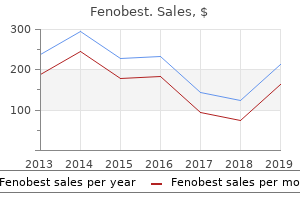
Albendazole (5 mg/kg tid for 15 to breast cancer awareness quotes cheap 20 mg fenobest mastercard 30 days) 42 menstrual cycle order 10 mg fenobest visa, an alternative treatment women's health center victoria bc order fenobest once a day, is believed by some to be more practical. Corticosteroids may be helpful if a large single lesion is inflicting signs by its mass impact. Other Cestode Infections Infection with Echinococcus sometimes affects the mind. The traditional sources of an infection are water and vegetables contaminated by canine feces. The typical lesion is a large fluid-filled cyst with the parasite visible by imaging procedures, however a solid nodular mind lesion, a "chitinoma," can also be recognized to occur. Cerebral coenuriasis (Coenurus cerebralis) is an uncommon infestation by larvae of the tapeworm Taenia multiceps. It happens mainly in sheep-elevating areas the place there are numerous dogs, the latter being the definitive hosts. The larvae type grape-like cysts, most frequently within the posterior fossa, which impede the spinal fluid pathways and cause signs of increased intracranial pressure. In Angiostrongylus infections, snails, freshwater prawns, and unwashed lettuce carry the nematode. The resulting illness could last for weeks to months, with pain, paresthesias, sensorimotor abnormalities, and a confusional state as the primary manifestations. Hodgkin illness, other lymphomas, and cholesterol emboli may also sometimes incite an eosinophilic meningitis. More detailed descriptions of parasitic ailments of the nervous system may be found within the monographs of Bia and of Gutierrez. These relationships and lots of others, which are the subject matter of this chapter, are of broad interest in drugs. A detailed dialogue of viral morphology and cell-virus interactions is beyond the scope of a textbook of neurology. Moreover, most antibodies and immunocompetent cells are excluded as well, in order that the identical mechanism that limits the entry of viruses additionally deters their removing. Another pathway of an infection is along peripheral nerves; centripetal motion of virus is accomplished by the retrograde axoplasmic transport system. Of these completely different routes of an infection, the hematogenous one is by far an important for the majority of viruses. The steps within the hematogenous unfold of an infection embrace crossing the blood-mind barrier through small vessels of the mind and the choroids plexus. Viruses cross each within migrating lymphocytes and directly through areas of glial and vascular areas that are permeable to the organisms. Mechanisms of Viral Infections Viruses, as soon as they invade the nervous system, have diverse medical and pathologic effects. To be susceptible to a viral an infection, the host cell will need to have on its cytoplasmic membrane particular receptor sites to which the virus attaches. Thus, some infections are confined to meningeal cells, enteroviruses being the commonest, during which case the medical manifestations are these of aseptic meningitis. Other viruses will contain particular classes of neurons of the mind or spinal wire, giving rise to the more critical problems corresponding to encephalitis and poliomyelitis, respectively. In some viral infections, the susceptibility of particular cell groups is even more particular. Other viruses are acquired by inoculation, as a result of the bites of animals. Following entry into the physique, the virus multiplies regionally and in secondary sites and often offers rise to a viremia. The virus or its nucleocapsid should be capable of penetrating the cell, mainly by the method of endocytosis, and of releasing its protective nucleoprotein coating. In acute encephalitis, susceptible neurons are invaded directly by virus and the cells bear lysis. Neuronophagia (phagocytosis of affected neurons and their degenerative merchandise by microglia) is a mark of this phenomenon. With other viral infections, zones of tissue necrosis of gray and white matter occur, and these changes could localize in particular areas. Only then will the inflammatory response to viral replication create signs (pain, weak point, sensory loss).
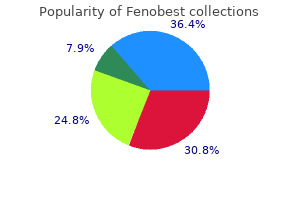
These adjustments are a lot the identical as those of "tobaccoalcohol amblyopia" (see above) women's health clinic redding ca cheap fenobest 20 mg with visa. The paresthesias womens health apta fenobest 20mg amex, impairment of deep sensation pregnancy 8 months cheap fenobest master card, and ataxia are because of lesions in the posterior columns. Weakness, spasticity, elevated tendon reflexes, and Babinski signs depend on involvement of the corticospinal tracts. The spinothalamic tracts may rarely be involved in the pathologic course of, which explains the occasional finding of a sensory level for ache and temperature on the trunk, as already famous. The distal and symmetrical impairment of superficial sensation and lack of tendon reflexes that happen in some sufferers are greatest explained by involvement of peripheral nerves and are mirrored in nerve conduction studies (see additional on, underneath "Diagnosis"). Pathogenesis Methylcobalamin is an important cofactor in the conversion of homocysteine to methionine. One of the better-understood functions of vitamin B12 is its position as a coenzyme in the methylmalonyl CoA� mutase reaction. In this reaction, which is a key step in propionate metabolism, methylmalonyl CoA is transformed to succinyl CoA, which subsequently enters the Krebs cycle. A lack of the cobalamin-dependent enzyme methylmalonyl CoA mutase results in the buildup of methylmalonyl CoA and its precursor, propionyl CoA. According to this theorized mechanism, propionyl CoA displaces succinyl CoA, which is the usual primer for the synthesis of even-chain fatty acids; this results in the anomalous insertion of odd-chain fatty acids into membrane lipids, corresponding to are found in myelin sheaths. Conceivably this biochemical abnormality underlies the lesions of myelinated fibers that characterize the disease. However, Carmel and associates have described a hereditary type of cobalamin deficiency during which methylmalonyl CoA mutase activity was normal, regardless of the presence of typical neurologic abnormalities. In their view, the first failure is one of methylation of homocysteine to methionine, i. Evidence for the latter view comes also from the observations, talked about earlier, that extended administration of nitrous oxide (N2O) may produce not only megaloblastic adjustments in the marrow (Amess et al) but in addition a sensorimotor polyneuropathy, usually combined with signs of involvement of the posterior and lateral columns of the spinal twine (Layzer). Probably N2O produces its effects by inactivating the methylcobalamin-dependent enzyme methionine synthetase. These and different hypotheses are mentioned by Jandl, Carmel and colleagues, and Beck. One known scientific mistake has been to deal with pernicious anemia by giving folic acid; this corrects the anemia however may worsen and even evoke the spinal twine lesions. There are, neverthe- less, a few reported examples of cerebral and spinal twine lesions indistinguishable from those because of vitamin B12 deficiency in sufferers with faulty folate metabolism- both in adults with acquired deficiency (Pincus) and in children with an inborn metabolic error (Clayton et al). Diagnosis the main differential diagnostic considerations of the combined sensory and motor options are cervical spondylosis (web page 1073), a number of sclerosis of the cervical twine (web page 778), rarities corresponding to the feminine provider state of adrenoleukodystrophy (adrenomyeloneuropathy, web page 836), and non-B12 � poor combined system disease (web page 1078). The final of these refers to an obscure myelopathic course of that affects the posterior and lateral columns subacutely however is unassociated with any type of B12 deficiency or associated enzyme derangement. Recent reports suggest that this course of could also be the result of an incompletely understood acquired type of copper deficiency. In a retrospective research of 141 sufferers with neuropsychiatric abnormalities because of cobalamin deficiency, there have been 19 sufferers in whom both the hematocrit and imply red blood cell quantity had been normal (Lindenbaum et al); in these sufferers, delicate morphologic abnormalities- hypersegmented polymorphonuclear leukocytes and megaloblastosis in bone marrow smears- had been nearly all the time discovered if fastidiously sought. Laboratory Diagnosis Serum cobalamin ought to be measured every time the analysis of vitamin B12 deficiency is in query. Microbiologic assay (using Euglena gracilis) is essentially the most accurate measurement, however the technique is time-consuming and cumbersome and has been largely replaced by a commercial radioisotope dilution assay (the cheap chemiluminescence assay is an alternative however barely less dependable). With the radioassay, a serum B12 level of less than 100 pg/mL is often related to neurologic signs and signs of vitamin B12 deficiency. However, even serum levels of 200 to 300 pg/mL should be associated (in 5 to 10 percent of cases) with cobalamin deficiency. High serum concentrations of cobalamin metabolites- methylmalonic acid (normal range, 73 to 271 nmol/L) and homocysteine (normal range 5. In a patient who stops absorbing ingested cobalamin, the serum levels may stay in the normal range for a very long time regardless of reducing tissue reserves. Antibodies to gastric parietal cells are also present in as many as ninety percent of sufferers with cobalamin deficiency, however this check usually yields false-positive results. The finding of serum antibodies in opposition to intrinsic issue is diagnostically specific however demonstrable in only 60 percent of cases in most sequence. Low cobalamin levels with or with out the scientific signs of deficiency may happen in sufferers with atrophic gastritis or after subtotal gastrectomy.
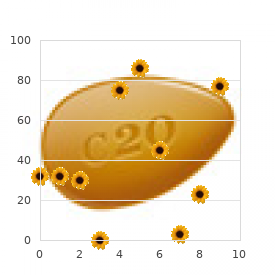
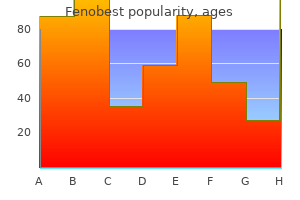
Axons of these sacral neurons menstruation running buy cheapest fenobest, constituting the preganglionic fibers breast cancer ultrasound results generic 20 mg fenobest visa, traverse the sacral nerves and synapse in ganglia that lie within the walls of the distal colon women's health ultimate bootcamp workout safe fenobest 20mg, bladder, and different pelvic organs. Thus, the sacral autonomic neurons, like the cranial ones, have lengthy preganglionic and brief postganglionic fibers- a characteristic that permits a circumscribed influence upon the target organ. Probably the neurons that activate striated muscle differ from those that innervate glands and smooth muscle. In the sacral segments, for instance, the neurons that activate the exterior sphincters (voluntary muscle) differ from others that provide the sleek muscle of bladder and rectocolon. In 1900, Onufrowicz (calling himself Onuf) described a discrete, compact group of relatively small cells in the anterior horns of sacral segments 2 to four. These neurons have been initially thought to be autonomic in perform, mainly due to their histologic features. Neurons in the intermediolateral cell column of sacral cord segments innervate the detrusor of the bladder wall. Axons of the nerve fibers originating in the intermediolateral column are of small caliber and are myelinated; when grouped, they form the white speaking rami. These preganglionic fibers synapse with the cell our bodies of the postganglionic neurons, which are collected into two large ganglionated chains or cords, one on each side of the vertebral column (paravertebral ganglia), and a number of other single prevertebral ganglia. Axons of the sympathetic ganglion cells are also of small caliber however are unmyelinated. Preganglionic fibers prolong from nuclei of the brainstem and sacral segments of the spinal cord to peripheral ganglia. The lateral-posterior hypothalamus is part of the supranuclear mechanism for the regulation of parasympathetic activities. Preganglionic fibers prolong from the intermediolateral nucleus of the spinal cord to the peripheral autonomic ganglia, and postganglionic fibers prolong from the peripheral ganglia to the effector organs, according to the scheme in. The postganglionic fibers of the prevertebral ganglia (situated in the posterior stomach rather than paravertebrally) form the hypogastric, splanchnic, and mesenteric plexuses, which innervate the glands, smooth muscle, and blood vessels of the stomach and pelvic viscera. The precept of the sympathetic preganglionic innervation of ganglia which might be placed past the bounds of the same old preganglionic paravetebral sympathetic outflow from the spinal cord. Some move as splanchnic nerves to prevertebral (posterior stomach) ganglia; some fibers also enter the sympathetic trunk, in which they move up or down for a variable number of segments. This is an exception to the rule that organs innervated by the autonomic nervous system obtain only postganglionic fibers. This special association can be defined by the fact that cells of the adrenal medulla are the morphologic homologues of the postganglionic sympathetic neurons and secrete epinephrine and norepinephrine (the postganglionic transmitters) immediately into the bloodstream. In this way, the sympathetic nervous system and the adrenal medulla act in unison to produce diffuse effects- as one would count on from their position in emergency reactions. By distinction, the parasympathetic effects, as in the pupil and urinary bladder, are extra discrete. There are three cervical (superior, middle, and inferior, or stellate), eleven thoracic, and 4 to six lumbar sympathetic ganglia. The head receives its sympathetic innervation from the eighth cervical and first two thoracic cord segments, the fibers of which move via the inferior to the middle and superior cervical ganglia. Postganglionic fibers from cells of the superior cervical ganglion follow the internal and exterior carotid arteries and innervate the blood vessels and smooth muscle in addition to the sweat, lacrimal, and salivary glands of the top. The arm � receives its postganglionic innervation from the inferior cervical ganglion and uppermost thoracic ganglia (the two are fused to form the stellate ganglion). The cardiac plexus and different thoracic sympathetic nerves are derived from the higher thoracic ganglion and the stomach visceral plexuses, from the fifth to the ninth or tenth thoracic ganglia. The terminals of autonomic nerves and their junctions with smooth muscle and glands have been tougher to visualize and research than the motor finish plates of striated muscle. As the postganglionic axons enter an organ, often via the vasculature, they ramify into many smaller branches and disperse, without a Schwann cell overlaying, to innervate the sleek muscle fibers, the glands, and, in largest quantity, the small arteries, arterioles, and precapillary sphincters (see Burnstock). Some of these terminals penetrate the sleek muscle of the arterioles; others stay in the adventitia. At the ends of the postganglionic fibers and partly alongside their course there are swellings that lie in shut proximity to the sarcolemma or gland cell membrane; usually the muscle fiber is grooved to accommodate these swellings.
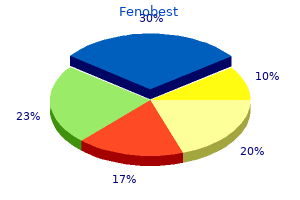
Moreover women's health clinic newcastle west purchase 20mg fenobest mastercard, in certain circumstances two processes incessantly contribute to menstruation 2 days only purchase discount fenobest depressing consciousness pregnancy x-rays discount fenobest amex, notably head injury combined with drug or alcohol intoxication. The successful management of the insensate affected person requires the companies of a well-coordinated team of nurses under the close steering of a physician. Necessary treatment should be instituted instantly, even before all of the diagnostic steps have been accomplished; diagnosis and treatment might need to proceed concurrently. The following is a quick outline of the ideas involved within the treatment of such sufferers. The details of management of shock, fluid and electrolyte imbalance, and other issues that threaten the comatose affected person (pneumonia, urinary tract infections, deep venous thrombosis, etc. Shallow and irregular respirations, stertorous breathing (indicating obstruction to inspiration), and cyanosis require the establishment of a transparent airway and delivery of oxygen. Arterial blood gases must be measured and additional observed by monitoring of oxygen saturation. The management of shock, if current, takes precedence over all other diagnostic and therapeutic measures. Concurrently, an intravenous line is established and blood samples are drawn for dedication of glucose, intoxicating medicine, and electrolytes and for exams of liver and kidney function. Hypoglycemia that has produced stupor or coma calls for the infusion of glucose, often 25 to 50 mL of a 50% solution adopted by a 5% infusion; this should be supplemented with thiamine. If the diagnosis is unsure, each naloxone and the glucosethiamine combination must be administered. With the development of elevated intracranial stress from a mass lesion, mannitol, 25 to 50 g in a 20% solution, must be given intravenously over 10 to 20 min and hyperventilation instituted if deterioration occurs, as judged by pupillary enlargement or deepening coma. With huge cerebral lesions, it could be appropriate to place a stress-measuring device within the skull of chosen sufferers (see Chap. A lumbar puncture must be carried out if meningitis or subarachnoid hemorrhage is suspected on the idea of head- 2. Management of the Acutely Comatose Patient Seriously impaired states of consciousness, regardless of their trigger, are sometimes fatal not solely as a result of they characterize a complicated stage of many ailments but additionally as a result of they add their own explicit burdens to the primary disease. In the case of meningitis, broad spectrum antibiotics that penetrate the meninges could also be instituted, especially if the lumbar puncture is delayed. As indicated above, gastric aspiration and lavage with normal saline could also be diagnostically and therapeutically helpful in some situations of coma because of drug ingestion. Salicylates, opiates, and anticholinergic medicine (tricyclic antidepressants, phenothiazines, scopolamine), all of which induce gastric atony, could also be recovered many hours after ingestion. Measures to forestall gastric hemorrhage and excessive gastric acid secretion are often advisable. The temperature-regulating mechanisms could also be disturbed, and extreme hypothermia or hyperthermia must be corrected. In extreme hyperthermia, evaporative-cooling measures are indicated along with antipyretics. The unconscious affected person can now not adjust the consumption of food and fluids by starvation and thirst. Both salt-dropping and salt-retaining syndromes have been described with mind disease (see Chap. If coma is prolonged, the insertion of a nasogastric tube will ease the issues of feeding the affected person and sustaining fluid and electrolyte steadiness. Otherwise, roughly 35 mL/kg of isotonic fluid must be administered per 24 h (5% dextrose in zero. Aspiration pneumonia is prevented by prevention of vomiting (gastric tube and endotracheal intubation), proper positioning of the affected person, and restriction of oral fluids. Should aspiration pneumonia occur, it requires treatment with appropriate antibiotics and aggressive pulmonary bodily therapy. An attempt could also be made to forestall it by the subcutaneous administration of heparin, 5000 U q 12 h, or of low-molecular-weight heparin, and by means of intermittent pneumatic compression boots. If the affected person is able to shifting, appropriate restraints must be used to forestall him from falling away from bed and to avert self-injury from convulsions. Prognosis of Coma (See additionally page 963) As a general rule, restoration from coma of metabolic and poisonous causes is far better than from anoxic coma, with head injury occupying an intermediate prognostic place.
Buy cheap fenobest line. Women's Health: Is hormone replacement therapy safe?.
